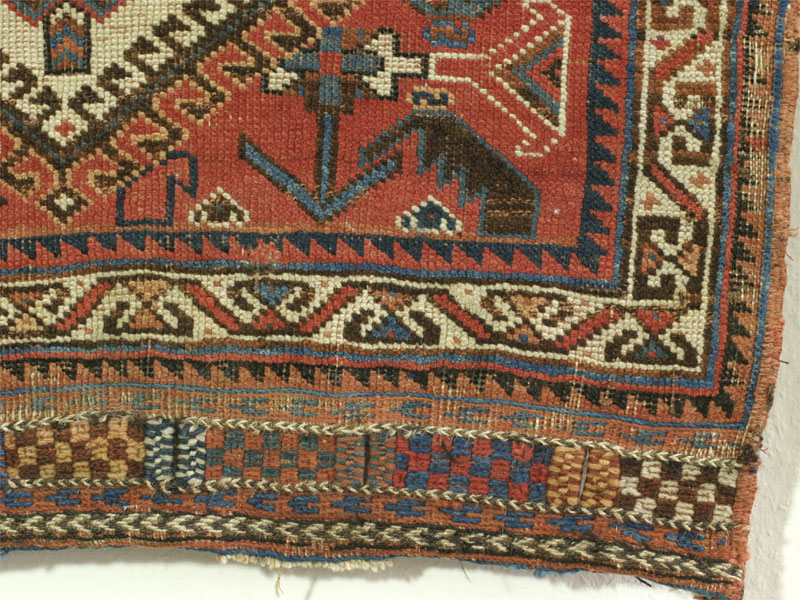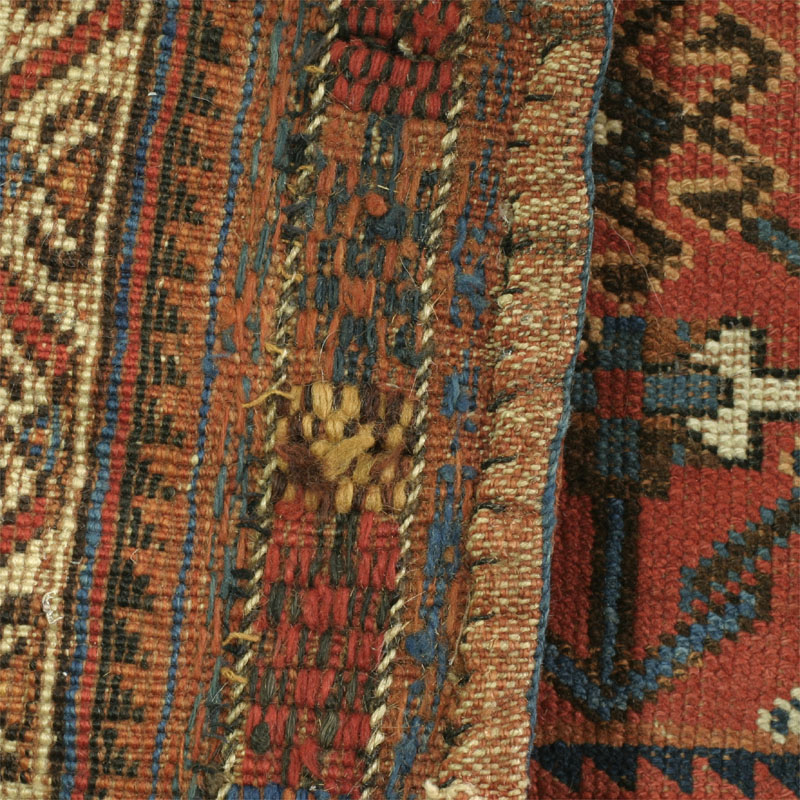The design is very playful and charming: a herd of goats mainly on the left side of the brick-red madder field in field surrounds a white diamond-shaped medallion with latch hooks extending inwards and outwards. The medallion frames a vertical pole which sees to cross an arrangement of smaller colorful diamonds and is crowned by three of the same kind of small diamonds. A flock of small crosses fills the white space, echoing the herd of goats (only with inverse weight). On the right side of the field, we find other elements: abstract blossoms, the half of a diamond flanked by serrated leaves (again, a faint memory of the Herati pattern), then what seems to be a flower with stem and leaves.
The main border is simple and beautiful, a white-ground meander band that reminds of (or represent?) animal heads with ramshorns. Here the small crosses occur as a filler motif.
Attribution is difficult; there is nothing specifically Khamseh about this bag, appart from the occurence of the disjoint serrated leaves that often appear in Khamse bags in a more regular fashion (compare this Khamseh khorjin, for example). Some features (ivory warps, orange red wefts, slightly depressed structure) seem to stand against a Khamseh attribution and point more towards a Qashqa'i attribution. The symmetrical knot alone that has been used here cannot solve the riddle since both tribes use symmetrical and asymmetrical kotting.
Weave, dye quality and the archaic design indicate that this bag could be quite early, perhaps around 1870. Certainly this is not a bag produced for the market, but for the tribsal context of use.
The bag face measures 1ft.0in. x 2ft.7in. (53 x 76cm). Off-white wool warps, a few plied with brown wool, dark brown across three inches on the left side. Light orange-red wool wefts, semi-depressed weave. Very tight and strong weave, firm but flexible handle. The original flat-woven back has been cut away, remnants are visible as they are sewn to the back of the piled face. The remaining side of the closing system showing a checkerboard design is intact, original, and very beautiful (see images). The checkerboard pattern is brocated on top of the plain weave, the eges of the vertical slits are strengthended with extra wrapping. The closure panels are framed and strengthened at top and bottom by narrow bands of extra twining in dark brown and white (looks like goat hair—you can see the bristles). Then comes a complementary-weft band of red and blue forming a pointed twill pattern (no extra wefts). This is followed by another complementary-weft brown-and-white twill pattern, this time in goat hair (feels stronger, thicker bristlier).(I hope I have worked this out correctly, based on Marla Malletts end finishings pages (www.marlamallett.com/end.htm)).
Very good natural dyes: madder-based brick red is the dominant colour, then there are lighter shades of red verging towards orange, beautiful shades of light, medium and dark indigo, off-white, a warm orange-yellow, medium brown, and dark brown.
The distortion and the traces of wear on the bag (especially in the central upper part that was the lower part of the bag in use) gives the impression that it has been used, though the condition is not at all bad. There is loss of the outer border at the top end, which needs to be secured. There is a little bit of repiling of white near the top of the medallion, beteween the latch hooks. The pile is quite short, some of it down to knotheads, with a bit of orange wefts visible in the white medallion. There is also more wear and foundation visible along the right edge (here, the original bag was most exposed). A weak area near the left edge has been repaired (probably in the original context of use) with a patch of khaki cotton roughly stiched to the back (see image).






